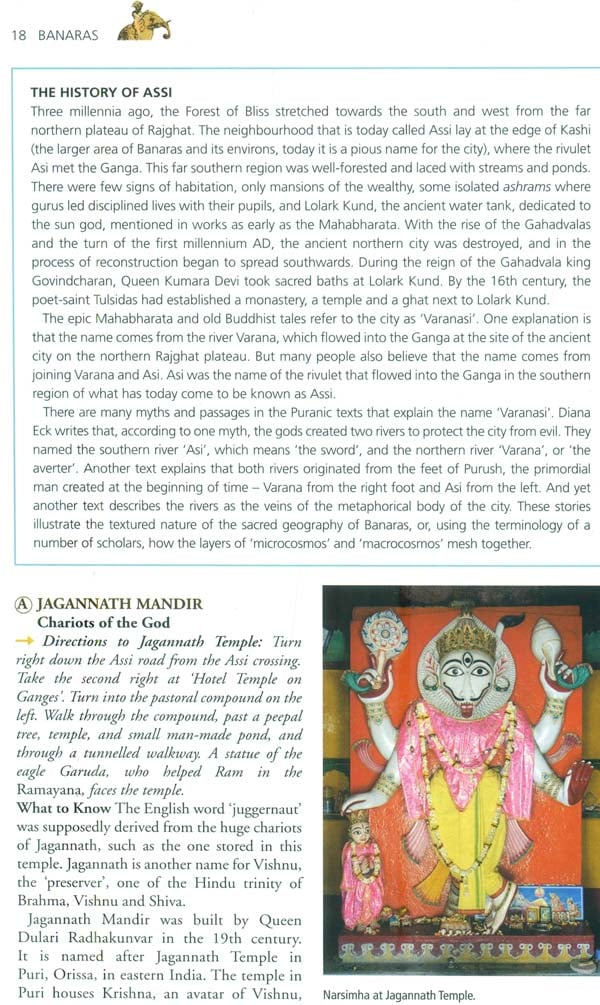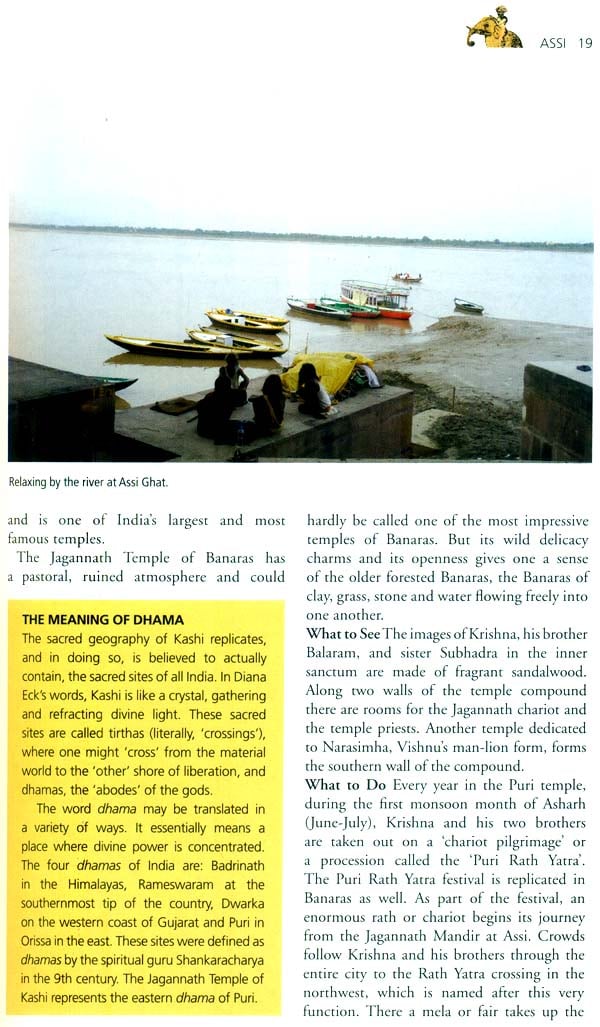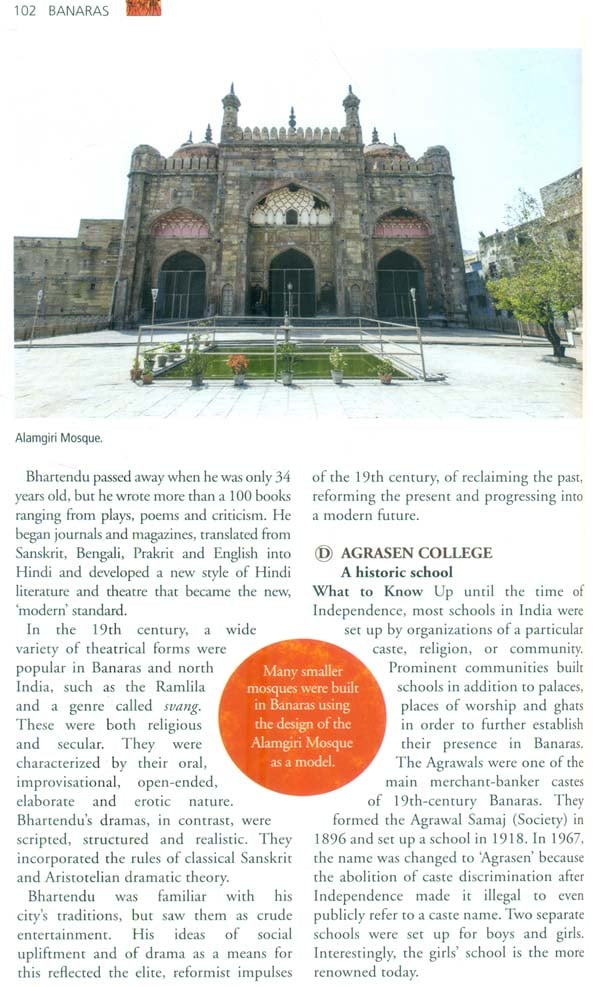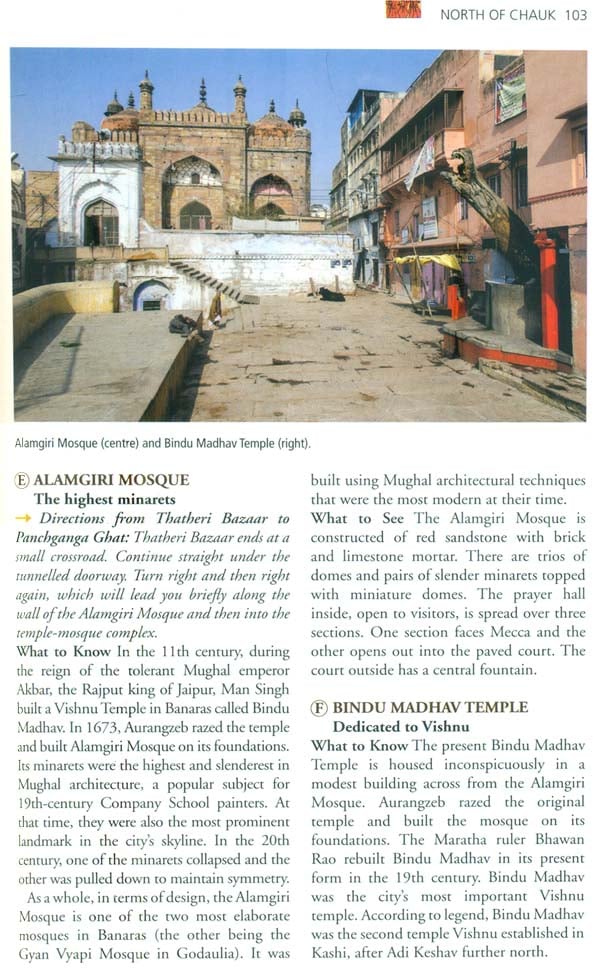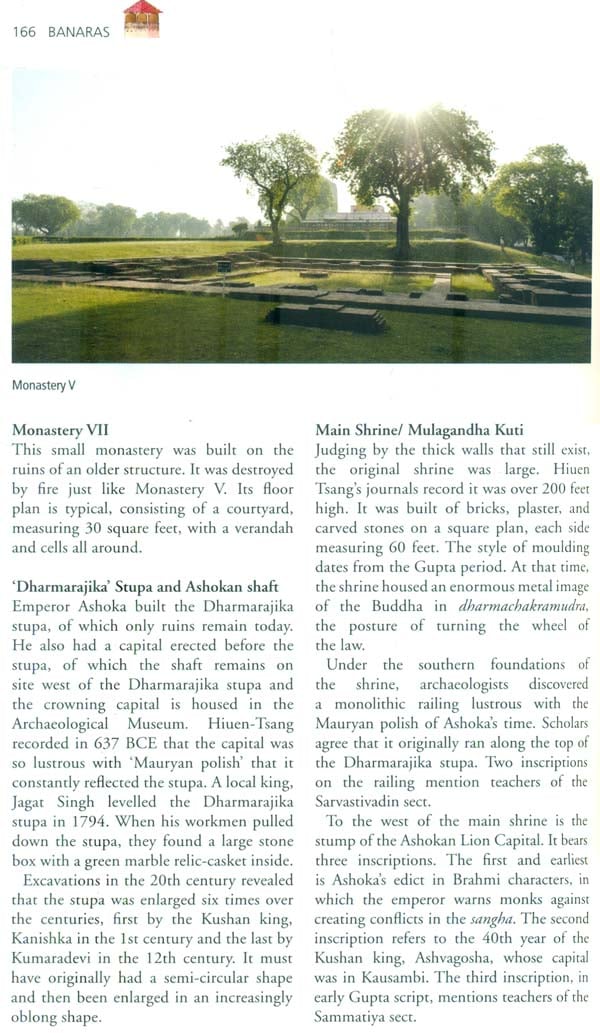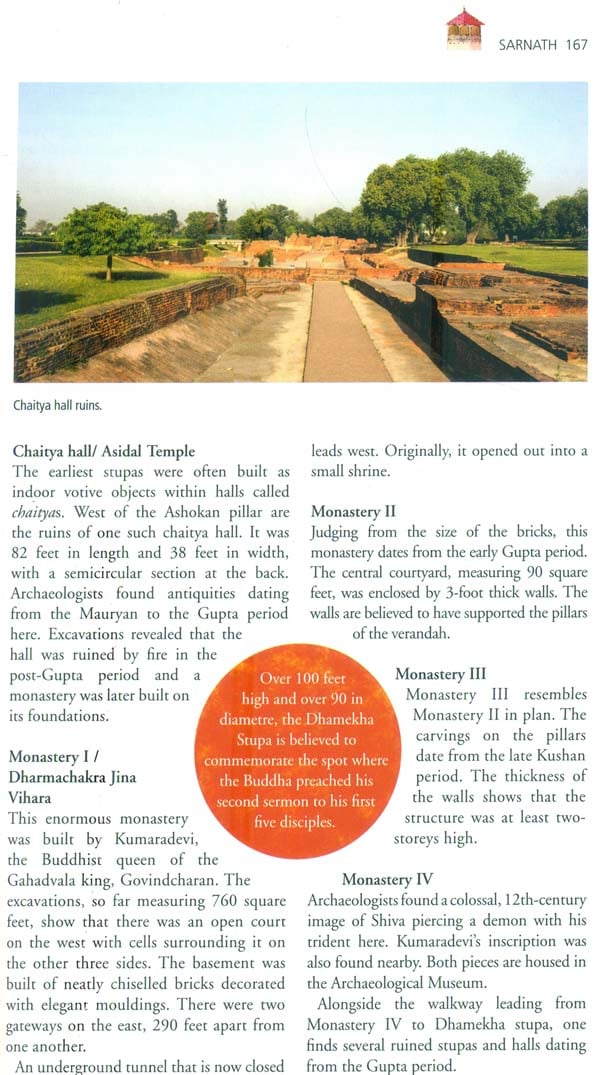
Banaras - Walks Through India's Sacred City
Book Specification
| Item Code: | NAP430 |
| Author: | Nandini Majumdar |
| Publisher: | Lotus Collection, Roli Books |
| Language: | English |
| Edition: | 2014 |
| ISBN: | 9788174369161 |
| Pages: | 184 (Throughout Color Illustrations) |
| Cover: | Paperback |
| Other Details | 9.0 inch X 5.5 inch |
| Weight | 410 gm |
Book Description
To most first-time visitors, even those from India, Banaras appears 'chaotic'. Its lanes are tangled and twisted, its logic hidden. I grew up in Banaras and that is how the city seemed to me as well. Perhaps that is why I wanted so much to discover Banaras. My hope is that, as you go on one walk after another, armed with this book, you will begin to unravel the city's secrets as I did. And soon, the city's tapestry will reveal itself to you in all its rich colour and texture. Walking and wandering is an art, especially in Banaras. Enjoy!
Nand in Majumdar has been associated since 2004 with NIRMAN, a non-profit organization based in Varanasi that works for education, the arts, and international exchange (www.nirman.info). At NIRMAN, she has also written children's books: Rain The River at Night; Cows; My School and Satya's Boat.
Constantino Schillebeeckx is a US-based freelance photojournalist.
The lanes of Banaras form a maze parallel to the river, running between homes, palaces, and places of worship. They run serpentine or jagged, rarely at right angles to each other, and only those born within them know their eccentricities by heart.
They are paved with fine-grained sandstone quarried from the nearby hills of Chunar. Walking through them, you lose your sense of time, place, and self, and are accompanied by a constant sense of discovery. The stone slabs play with scents and light, your senses and psyche. The air, moving through the lanes of stone, shifts from stillness to breeze. Sometimes the buildings breathe down on you. Other times, they seem to cradle you, slowing your breath, the pace of your thoughts.
Within rooms facing the street, artisans work at handlooms and lathe machines. Wooden shuttles clatter as they weave silken threads into warp and weft. At crossings, shopkeepers lay out spirals of betel leaves and jars of savoury snacks. They pour steaming tea and ladle chilled yoghurt into clay cups. You move past squares and old wells. Sometimes you flow along in a stream of people and animals. Other times, you are alone, save for a pillar that is centuries old, but continues to stand in its original form.
As you walk, you encounter the Hindu gods and goddesses in their countless forms. Idols of Shiva, Vishnu, and Devi frame doorways and crowd the roots of peepal trees. It is said that Banaras is home to 330 million gods. This extended family of gods and goddesses are related to one another through an enormous corpus of mythology, which finds material expression in the city's sacred sites and spaces.
Of all the gods, you meet Shiva the most. Shiva, the god of death, destruction, and dance, defies all categories and conventions. He is a mountain ascetic, a dweller of the cremation ground, and a bridegroom dressed in brilliant silks. He wears, at different times, a garland of skulls and the crescent moon in his hair. His name means 'auspicious', 'blessed', 'gracious', but he reveals himself in the inauspicious and terrible. He bestows blessings and wields weapons. Banaras is Rudravasa, the city of Shiva (also called audrd, 'the wrathful'), resting on the middle prong of his trident. It is also Avimukta, the city 'never forsaken' by him. Other gods and goddesses make room for at least one Shiva linga, Shiva's symbol, in their temples. There is a saying in Banaras, Washi ke kankar me Shiva shankar!' or 'Lord Shiva is in every pebble of Kashi'. So Shiva is not just in shrines and temples, but in every particle of dust in Banaras. As you walk, you will also encounter mosques and Sufi shrines. These are significant parts of Banaras, making it an important Islamic city even while it is known as a Hindu one.
Through the lanes, you can walk from the southernmost to the northernmost tip of the city. Or, head east at any point and you will, around a corner, following a twist, reach the river. Here by the river, the lanes give way to stairs that sweep down to the water's edge, interrupted by landings, called ghats. You stand on the topmost step, looking across the wide, floodlit Ganga to the quiet other shore. The buildings behind you form a stone facade famous the world over, dotted with old trees, bamboo umbrellas, and temple spires. At dawn and dusk, the panorama of the riverfront curving north is illuminated like nothing else in the world.
The river, ghats, and lanes make up the fabric of Banaras. Over the centuries, religion, commerce, and the arts have given birth to a special spirit that moves through the city's lanes. This spirit is a joie de vivre called mauj and masti, or abandon and craziness. You achieve it through a glass of frothy thandai, a dip in the Ganga, a nap under a tree, an unannounced stop at a friend's, an open-air music session, or a trip to the local saint's tomb. It reflects the Hindu belief in balancing kama, artha, dharma, and moksha. Kama means sensual pleasure, intensity of emotion, and aesthetic enjoyment, found in temples and in the arts, but also in the smallest gestures and actions. Artha is practical action rooted in the material world. Dharma is relevant action, the right thing done at the right time, sometimes translated as 'duty'. Moksha is release from the worldly cycle of reincarnation. The key to happiness is achieving a balance between the four life goals effortlessly, with the blissful freedom characteristic of the long-haired Shiva dancing bare-chested in his leopard skin.
Many scholars call the city 'pre-modern', for Banaras has escaped industrialization. The city's main industries are home-based crafts — weaving, embroidery, stonework, metalwork, and woodwork. And so, comparatively, homes here are humble, concerns simple, and lives carefree. It is no coincidence that home-based production has produced a culture of freedom and pleasure. One anthropologist writes about a much-loved metaphor among the people of Banaras, that of khulapan, or openness. What Banarasis value is a khula dil (an open heart), a khula mijaz (an open nature), and khuli bat karna (speaking openly). They equally treasure the little bit of open space, the khuli jagah, in the heart of their neighbourhood. For them, happiness is the easy movement through the layers of the self and the world.
So, how can we understand the spirit of the city? Banaras is an open place. All one must do is step out into its lanes.
Mark Twain quipped, 'Benares is older than history, older than tradition, older even than legend, and looks twice as old as all of them put together!'
In the 1940s railroad constructors working on a high strip of land in northeast Banaras accidently unearthed the brick remains of an ancient city. Two decades later archaeologists excavated pottery, implements, and seals, which they dated to the 8th century BCE. This was one of the oldest settlement sites in the world, as old as Jerusalem and Athens.
Let us go back to the start of this fascinating story. We can only wonder if ancient Kashi was the base of an Aryan tribe called Kashi or perhaps the capital of the Kashi kings who fought in the famous war described in the Sanskrit epic, Mahabharata. We do know, from the Mahabharata, the ancient Hindu texts called the Puranas, and the Buddhist Jataka tales, that between the 8th and 6th centuries BC, Kashi was one of the sixteen great kingdoms of the Aryans, along with Magadha to its east and Koshala to its north. Magadha and Koshala competed repeatedly for power over Kashi, for Kashi was situated strategically on the Ganga and along the largest trade route in India at the time, which connected eastern India to the north-west. Kashi was already an important commercial centre. The Jataka tales and the Puranas describe the city's abundant wealth, the productivity of its workshops, and the quality of its products, particularly its fabrics.
Not just the city, but the entire area of the city and its environs, called `Kashi', was coveted by the gods and humans alike from that ancient time. Mahatmyas, or poems of praise, found in the ancient texts the Puranas describe in rich detail the area surrounding the gated city.
Kashi was Anandvana or the 'Forest of Bliss', lush with silver, slender kasha grass (from which, perhaps, comes the name Kashi). It was thick with groves and gardens and filled with birds and bees. The Forest of Bliss remained this way, open and lush, into the 19th century. The accounts of travellers and the maps of James Prince, an East India Company cartographer, capture its geography over the centuries. Kashi was divided into five forest tracts and laced with lakes and streams that drained into one another, swelling and sinking with the rhythms of the river. Residing in the Forest of Bliss three millennia ago were pre-Aryan, local deities called ganas, ganeshas, nagas, yakshas, and devis. These were mostly associated with ponds and trees, their presence honoured simply, with a swathe of red thread around a tree trunk or a daub of vermillion on a stone. They were popular heroes, serpent gods and goddesses, and mother goddesses.
The Forest of Bliss attracted worshippers of these ancient local dieties. It also attracted religious seekers and seers, who challenged the Vedic religious system and its emphasis on Sanskrit texts, the power of priests, and elaborate rituals. Instead they focused on introspective wisdom (gyan) and new perspectives (darshan). The forests and streams of Kashi were ideal for hermitages and tempted the most radical new gurus. Gautam Buddha was one of these teachers. A prince by birth, he had travelled far from his kingdom, seeking enlightenment. At Banaras, he identified his first five disciples and delivered his first sermon. In the centuries following the Buddha, other great teachers lived and taught in Banaras — the grammarian Patanjali, the philosopher Shankara, and the theologian Ramanuja.
It was from the local deities of the Forest of Bliss that the great gods of Hinduism, Vishnu and Shiva, and the goddess, Devi, arose and established themselves in Banaras. The Buddhist Jacaka tales, the epics Mahabharata and Ramayana, and the Puranas record the development of Hinduism and Mahayana Buddhism. Over the next millennia, Vishnu and Shiva gathered as entourages and incarnations the various local deities. Some ganas and devis became independent gods and goddesses, like Ganesh, Sitala, and Kali. Others became consorts of the great gods, like Parvati. The concept of bhakti or devotion developed, as rituals of worship evolved from ancient practices. The Mauryas in the 3rd and 4th centuries BCE and the Kushanas in the 1st century CE were patrons of Buddhism. The war-weary Mauryan emperor Ashoka converted to Buddhism and travelled to the township of Sarnath, outside Banaras, where the Buddha first attained enlightenment under the Bodhi tree. Ashoka developed a Buddhist town there with monasteries and temples. His famous lion capital stands in the Sarnath museum today. Then in the 4th century CE the Bhara Shivas and the Guptas ushered in a glorious age for Hinduism. They built temples and sanctioned religious texts to be written. By the end of Gupta rule in the 6th century CE the Hindu pantheon was firmly established and devotional movements of all kinds flourished.
| acknowledgements | 7 | |
| Introduction | 9 | |
| Wolk 1 | On the Trail of the Sun God at Assi | 14 |
| Wolk 2 | Through the Winding Lanes of Shivala and Sonarpura | 34 |
| Wolk 3 | Marvel at Silk Workshops in Madanpura | 48 |
| Wolk 4 | Revel in Colourful Godaulia | 62 |
| Wolk 5 | Explore the heart of Banaras at Chauk | 74 |
| Wolk 6 | Journey Back in Time to Manikarnika | 82 |
| Wolk 7 | Savour the Old City North of Chauk | 94 |
| Wolk 8 | Escape to Serene Rajghat | 108 |
| Wolk 9 | Wander through Old-fashioned | 120 |
| Wolk 10 | In the Footsteps of the Gurus at Laksa | 130 |
| Wolk 11 | Discover the Extraodinary Ghats | 142 |
| Wolk 12 | Explore Ruins and Relics | 154 |
| Other Places of Interest in Banaras | 176 | |
| Bibliography | 178 | |
| Index | 179 |
